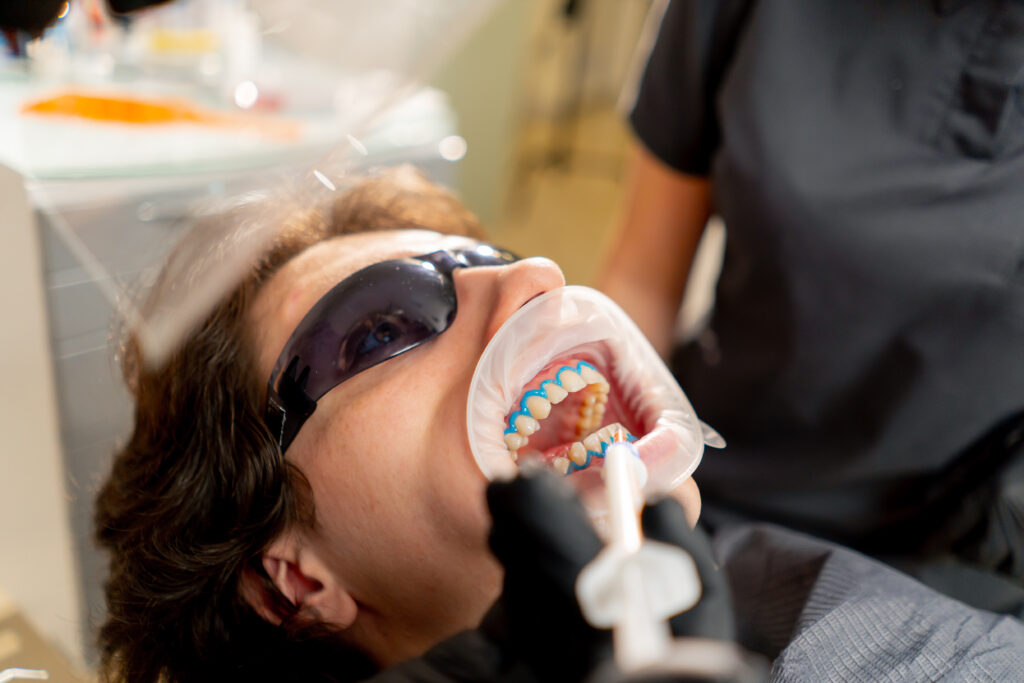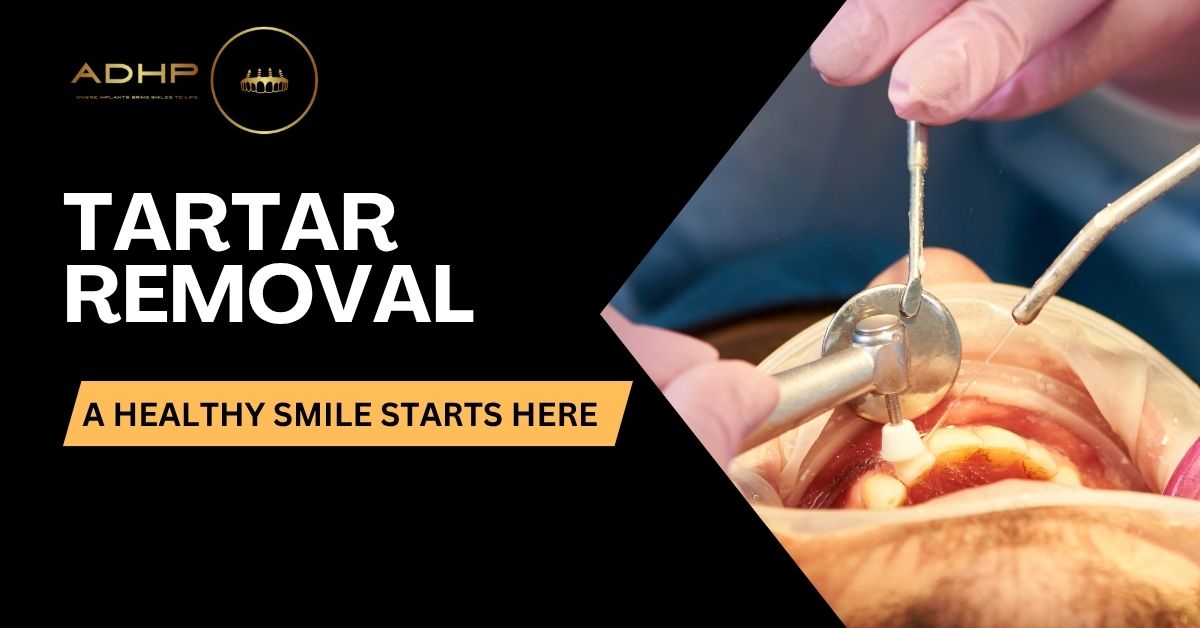Main Takeaways:
-
Tartar is hardened plaque that forms quickly and can only be removed by a dental professional—not by brushing or flossing.
-
Tartar buildup can lead to serious oral and systemic health issues, including gum disease, tooth decay, bad breath, and increased risk of heart disease and diabetes.
-
Professional cleanings, including scaling and root planing, are essential for removing tartar and maintaining gum health.
-
Prevention starts at home with daily brushing, flossing, a balanced diet, and avoiding sugary, sticky foods.
-
Lifestyle habits like smoking accelerate tartar formation and interfere with healing—quitting greatly improves oral health.
-
Children and dental implants are also vulnerable to tartar buildup, so consistent care is necessary across all age groups and dental conditions.
-
Regular dental visits (every 6 months or as needed) and choosing an experienced provider like ADHP – Fallbrook are key to long-term oral health.
Maintaining a radiant, healthy smile goes beyond just brushing and flossing. One of the most overlooked yet essential components of oral hygiene is tartar removal. Tartar, also known as dental calculus, is a hardened form of plaque that adheres stubbornly to teeth and can lead to serious dental issues if left untreated. Understanding how tartar forms, the dangers it poses, and how to remove and prevent it is crucial for anyone aiming to preserve their oral health long-term.
Explore everything you need to know about tartar removal. From professional treatments and at-home prevention to the long-term effects of ignoring buildup. Let’s dive in and uncover the secrets to maintaining a cleaner, healthier smile.
What Is Tartar and How Does It Form?
Tartar is the calcified version of plaque—a sticky film composed of bacteria, food particles, and saliva. When plaque isn’t removed through proper brushing and flossing, it hardens within 24 to 72 hours and becomes tartar. Once formed, tartar cannot be removed by brushing alone and requires professional dental tools for complete removal.
It typically accumulates along the gumline, between teeth, and in hard-to-reach areas of the mouth. The rough surface of tartar makes it easier for more plaque to accumulate, creating a vicious cycle that increases your risk for tooth decay, gum disease, and even systemic health problems.
Why Tartar Removal Is So Important
Tartar doesn’t just affect the appearance of your teeth—it poses serious threats to your oral and overall health. Here are some key reasons why tartar removal is crucial:
- Prevents Gum Disease: Tartar buildup irritates and inflames the gums, potentially leading to gingivitis or the more severe periodontitis.
- Reduces Bad Breath: Bacteria trapped in tartar can emit foul-smelling compounds.
- Protects Tooth Enamel: Tartar harbors acids that can erode enamel and lead to cavities.
- Improves Aesthetics: Tartar can appear yellow or brown, affecting the appearance of your smile.
- Minimizes Risk of Systemic Conditions: Poor oral health has been linked to heart disease, diabetes, and respiratory infections.
By making tartar removal a priority, you protect more than just your teeth—you’re investing in your total body health.
Professional Tartar Removal: What to Expect at the Dentist
Once tartar has formed, only a dental professional can remove it effectively. During a dental cleaning, your hygienist uses specialized instruments to gently scrape away tartar from above and below the gumline.
Scaling and Root Planing
For more extensive buildup, especially beneath the gums, a deeper cleaning procedure known as scaling and root planing may be recommended. This involves:
- Scaling: Removing tartar from the surface of teeth and under the gumline.
- Root Planing: Smoothing the tooth roots to prevent future plaque adhesion.
This method not only removes existing tartar but also helps reduce inflammation and allows the gums to reattach to the teeth.
Can You Remove Tartar at Home?
While brushing and flossing can prevent tartar from forming, they cannot eliminate it once it has hardened. However, certain products and habits can help slow down or minimize buildup.
Dental Tools for At-Home Maintenance
Some over-the-counter dental kits include scraping tools or tartar-control toothpastes. These can be helpful when used correctly, but improper use can damage enamel or gums. Always consult your dentist before attempting at-home scraping.
Natural Remedies
A few natural substances are believed to help reduce plaque before it hardens:
- Baking soda: Neutralizes acids and provides mild abrasion.
- Hydrogen peroxide: Helps reduce bacteria when diluted and used as a rinse.
- Oil pulling: Swishing coconut or sesame oil may reduce oral bacteria, though it doesn’t remove tartar.
These methods can support your dental care routine, but they are not substitutes for professional tartar removal.
The Role of Diet in Tartar Prevention
What you eat plays a significant role in your oral health. Some foods encourage plaque formation, while others can help fight it.
Foods That Promote Tartar Buildup
- Sugary snacks and drinks
- Refined carbohydrates (like white bread and chips)
- Sticky foods that cling to teeth
Foods That Help Fight Plaque
- Crunchy fruits and vegetables (like apples and carrots)
- Cheese and yogurt (rich in calcium and phosphate)
- Green tea (contains antioxidants that reduce inflammation and bacteria)
Incorporating more tooth-friendly foods into your diet can support your body’s natural defenses against plaque and tartar.
How Smoking Affects Tartar Formation
Tobacco use is one of the leading risk factors for excessive tartar buildup. Smoking decreases saliva production and promotes the growth of harmful bacteria in the mouth. This combination accelerates plaque and tartar development and also interferes with healing after tartar removal procedures.
Quitting smoking not only enhances the appearance of your teeth but also greatly improves your chances of maintaining long-term oral health.

How Often Should You Get Tartar Removed?
For most individuals, dental cleanings every six months are sufficient to manage tartar. However, some may require more frequent visits, especially if they:
- Smoke
- Have braces or retainers
- Suffer from chronic gum disease
- Experience excessive plaque buildup
Your dentist will recommend the ideal frequency based on your oral health status. Regular appointments ensure tartar is addressed before it leads to serious complications.
Tartar vs. Plaque: What’s the Difference?
Although often used interchangeably, plaque and tartar are not the same:
- Plaque is a soft, sticky biofilm that can be removed with regular brushing and flossing.
- Tartar is the hardened, calcified form of plaque that requires professional intervention.
Understanding the difference is essential so you can catch early signs and take preventive measures before plaque turns into tartar.
Tartar and Gum Recession
When tartar forms near the gumline, it can push the gums away from the teeth, causing recession. As the gums pull back, the roots of the teeth become exposed, leading to increased sensitivity and a higher risk of infection.
Tartar removal is a key preventive step in avoiding gum recession. Once recession has occurred, only periodontal treatments or grafts can repair the damage—another reason not to delay dental cleanings.
Tartar Buildup on Dental Implants
Dental implants are not immune to tartar. While the implant itself cannot decay, the surrounding gum tissue can still become inflamed if tartar is allowed to accumulate. This condition, known as peri-implantitis, can compromise the integrity of the implant.
Maintaining a regular tartar removal routine is just as important for those with implants as it is for natural teeth.
Children and Tartar: What Parents Should Know
Children can also develop tartar if their oral hygiene is inconsistent. It’s vital for parents to teach proper brushing and flossing techniques early on and schedule regular dental visits.
Pediatric tartar removal is generally quick and painless, but prevention is key. Tartar in children can be a sign of sugary diets or inadequate brushing habits, both of which should be addressed promptly.
The Link Between Tartar and Chronic Conditions
Poor oral health is more than just a localized problem. Tartar buildup has been linked to systemic issues, including:
- Cardiovascular disease: Inflammation in the gums may contribute to hardened arteries.
- Diabetes: Gum disease can make it harder to control blood sugar levels.
- Respiratory infections: Bacteria from the mouth can be inhaled into the lungs.
By prioritizing tartar removal, you’re also taking proactive steps toward safeguarding your general health.
Choosing the Right Dental Practice for Tartar Removal
Not all dental clinics are created equal. When selecting a provider for tartar removal, look for the following qualities:
- Experience in periodontal care
- Modern dental equipment
- Clear communication and patient education
- Positive patient reviews and testimonials
A reliable dental office will not only perform efficient tartar removal but also provide guidance on maintaining oral hygiene between visits.
Tartar Prevention Is Better Than Cure
Tartar removal is a vital part of maintaining oral health and overall well-being. Regular dental visits, consistent hygiene practices, and a balanced diet all work together to keep tartar at bay. Ignoring it can lead to irreversible damage—not just to your smile, but to your health as a whole.

Ready for a Cleaner, Healthier Smile? Visit ADHP – Fallbrook
If you’re ready to take control of your oral health and say goodbye to stubborn tartar, trust the experts at ADHP – Fallbrook. Our experienced dental professionals specialize in gentle yet thorough tartar removal using the latest techniques and technology. Whether you need a routine cleaning or more advanced periodontal care, we’re here to help you achieve a healthier, brighter smile.
Don’t wait for tartar to take a toll on your teeth—schedule your consultation with ADHP – Fallbrook today and experience personalized dental care you can count on.


